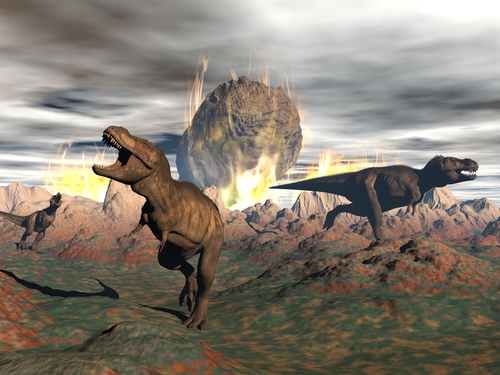 Ben: OK, everyone. Forget Tesla. It’s time to start obsessing about Luis Alvarez.
Ben: OK, everyone. Forget Tesla. It’s time to start obsessing about Luis Alvarez.
[That’s Luis Alvarez in the photo, standing in front of the Great Artiste. This post began, as so much in life does, with a Twitter conversation. Ben Lillie, a physicist and writer, began it; other people added to it. One of those people was Hope Jahren, who is a biogeochemical paleontologist or something, and her additions took the whole thing right out of the realm of Twitter and into the Land of the Blog Post.]
Ann: Oh, I’ve heard of Luis Alvarez. He was a famous physicist. And he and his son, Walter, did something important about dinosaurs but I forget what. Whatever it was, I think they did it later on.
Ben: Right. This even starts out crazy. For his graduate work, Alvarez helped discover that cosmic rays are partly made of antimatter. I still meet (well, tweet) people who think anti-matter is fiction. But no, it was found in 1932. Today it’s so common we use it for medical procedures (such as PET scans). Later he also used cosmic ray muons to search for hidden chambers in the pyramids at Giza.
Ann: During the second World War, he invented the aircraft blind-landing system. And according to another Alvarez-enthusiast, @andrewtlloyd, while Alvarez was working on the landing system, he met Arthur C. Clarke and Clarke based his novel “Glide Path” on him.
Ben: OK, and then it turns out that Luis Alvarez was flying in formation with the Enola Gay when it dropped the atomic bomb on Hiroshima. And @andrewtlloyd said that the name of the plane Alvarez was on was Great Artiste, and that during the next bombing run, on Nagasaki, he dropped this letter to Japanese scientists. !!
Ann: And after the war, he and Edward Teller pushed for the next biggest bomb — the H bomb, the Super — that nobody else wanted.
Ben: Oh, I forgot the part where Alvarez won the Nobel Prize for *improving* the design for the Bubble Chamber. This guy personified Steampunk — tinkering at this and that and making amazing things. Also, bombs and evil stuff.
Ann: @andrewtlloyd wrote that his father worked for Alvarez at the Lawrence Berkeley lab, building bubble chambers and then in 1962, Alvarez went to Vietnam to work on the starlight scope, and his attache was Daniel Ellsberg, of the Pentagon Papers. The starlight scope was basically night vision binoculars, and Alvarez convinced the army it might be a good idea for fighting insurgents at night.
Ben: ?!??!?! Damn, it just keeps going.
Ann: Also during the Vietnam War, he invented a chemical sensor called a people-sniffer that could tell the difference between a Vietnamese and an American soldier. I didn’t actually believe that when I heard it and though my sources were good, I’m not sure I believe it now.
Ben: Oh, I also forgot the part where he analyzed the footage of the Kennedy Assassination. OF COURSE HE DID How is this guy not a legend?
Ann: He liked high-powered secret elite club groups. He was a member of Jason and of the Bohemian Club. He probably did some real good for the country as a Jason but the Bohemian Club, as far as I can tell, is of use only to its members.
Hope: He also said crazy mean shit to the NYT about paleontologists not being real scientists. The paleo-field is still licking its wounds over that one.
Ben & Ann: What? No. Tell us more. 
Hope: I never figured out this part of the story until I began teaching about dinosaurs in my classes in 2003 or so. I went to grad school in the early 90s at Berkeley, and it was truly odd how Paleontology was wholly on one side of campus within the Biology department, yet all things Geological were in the Geology Department, physically located on the other side of campus. Heck, they were in different Colleges for goodness sakes. I was studying the chemical properties of a mineral that had been formed as part of a plant (somewhat like how a peach pit forms), that shows up in the fossil record, so I had obvious interests in both fields. The two departments were like that puzzling friend’s house, that you knew in college, where her parents were still married for 30 years and living in the same house but had separate bedrooms and conveniently always avoided being on the same floor together. My understanding is that this dynamic all went back to hard feelings over the Alvarez-iridium-dinosaur thing.
Ann: The Legacy of the Alvarez-Iridium-Dinosaur Thing. I hardly know where to start.
Hope: I do. I refer to the dominant theory of dinosaur extinction as “EXIT” (“Extraterrestrial Impact Theory”), a theory based on original work by Luis Alvarez and colleagues during the 1980s. The moment of Geological Time after which dinosaurs have never been reported is called the “K/T boundary” (~65 million years ago). The extinction of the dinosaurs is a spellbinding question that has always captured the curiosity of scientists. Of course paleontologists had been furiously studying the event for one hundred years prior to EXIT, but there was no consensus or even partial consensus as to what caused the extinction. Alvarez and colleagues used this to their advantage. Here’s the meat of EXIT: In many sites, a several-cm layer of clay shows up at the K/T boundary, and Alvarez et al 1980 analyzed this clay for iridium content and found about 50 times more iridium (“Ir”) in K/T clay than in your average sedimentary rock.
Ann: I think I’m remembering this now. Meteorites have a lot of iridium, right?
Hope: Yes. From this they hypothesized: A ~5 mile (diameter) asteroid, crashed into earth and sent dust-particles from both earth and meteorite into the atmosphere, which was then deposited globally as clay layer. (This 5-mile figure was back-calculated from the amount of Ir in the dust). But the paper was very light on mechanism i.e., paleontologists wanted to know how this asteroid killed all the dinosaurs but keep most everything else intact? Did a piece of meteorite hit every single dino on the head and kill him/her or what? — so from the beginning, paleontologists were skeptical, and for good reason.
Ann: If you’re saying that a meteorite killed the dinosaurs, wouldn’t you want to explain how?
Hope: Here’s all the original paper (14 pages in Science, mind you) said about mechanism: “Most food chains collapsed and extinctions followed.” There is also general yammering about how sunlight was blocked out and photosynthesis stopped. This was super problematic for paleontologists because large scale extinctions in plant communities had not been observed at the K/T. Instead of fully addressing and discussing the mechanism, on page 14 they just state that: “A number of puzzles remain.” and “We will not go further into this matter.” “We will not go further into this matter”? WHO GETS TO SAY THAT TO SCIENCE MAGAZINE?
Ann: Nobody. Or maybe physicists do. How did physicists happen to be publishing about extraterrestrial impacts and dinosaurs in the first place?
Hope: I know, right? L. Alvarez et al, Science, 1980 was led by a guy who had never published anything about Paleontology ever before. Who gets that much bandwidth in Science for their first study in a new field? All the authors were physicists, with the exception of Walter Alvarez, Luis’s son (a stratigrapher). They were also arguably the most powerful scientists in the whole world, Alvarez having won the Nobel Prize in 1968 and having been a major player in matters of national security. EXIT is much better fortified with chemistry and physics (e.g., iridium concentration measurements, meteorite projectile calculations) than with paleobiology (e.g., specificity of extinction, biological mechanisms). Because these physicists were viewed as “outsiders” to the problem they may have lacked credibility with paleontologists, but they were welcomed by the public and the media for their seductively “new take” on a compelling but perennially unanswered question.
Ben: Physics explains all things! All at once! Because Occam’s Razor. Duh.
Hope: Instead of returning to the fossil record to test the idea of an instantaneous (EXIT) vs. gradual mechanism — or (Heavens!) collaborate with a paleontologist to figure it out — L. Alvarez went on a vicious offensive to disparage and thus discredit paleontologists as weak-minded, qualitative “stamp collectors” in order to achieve pre-dominance for EXIT (e.g., the NYT article). This was cruel. Paleontologists are generally poorly funded, museum-curator types. Scientifically, it was like kicking a three-legged dog.
Ben: Yeah, I did know about that. My dad was a geophysicist, and I’m a physicist. We both did unrelated work, but my view was presumably skewed. Physicists are dicks. <whistles and walks away quietly>
Hope: I don’t agree — all my friends in grad school were physicists. But assholes and dinosaurs do sometimes seem to be inseparable.
Ben: One assumes that every dinosaur had one, yes?
Hope: There’s a Nature paper in there somewhere.
Ann: “Multi-Determinate Meaning of the Word, ‘Asshole,’ in the Field of Paleontology.”
Hope: Anyway, here’s my Big Important Take on this: The EXIT paper of Alvarez et al. represented a movement in the field away from a discussion of the fossils themselves, and into a discussion of the physical environment. We are only now coming back to discussing the organisms (e.g., dinosaur behavior, ecology, physiology, etc.). This shift has been both good and bad. Personally, I don’t think we’ll ever solve this until we know more about how dinosaurs worked. Yes it’s clear that there was a meteorite. But we need a mechanism specific to extremely large terrestrial reptiles, to render them non-viable, but leave other stuff less affected. In my eyes, to get there we need more specific information about their diet, metabolism, oxygen requirements, cold-bloodedness, reproductive systems, etc. I’d like to see the future of the field go that way … more physics is not the answer.
___________
Photo credits: Luis Alvarez & The Great Artiste – Wikimedia Commons; iridium layer about to be laid down – Shutterstock
As a retired “earth-scientist” with the USGS, I remember the arguments raging around Alvarez’s hypotheses and had associates involved in most of the camps. Since the initial publication in Science, an enormous amount of work and further evidence gathering has occurred and the case seems to be very solid for an enormous asteroid impact on the Yucatan peninsula at exactly the KT boundary.
Not just dinosaurs vanished… Most mammal, avian, and reptile species also perished, and the dominant plant pollens also vanished for a time (except for a huge burst of fern spores -indicating large scale disruption of the whole ecosystem).
There are a lot of valid questions to be answered about the details of the mechanisms causing the nearly total collapse of the terrestrial ecosystem (the oceans were also badly impacted, but the number of extinctions may have been fewer). But as both a biologist and a geoscientist the validity of the mechanism seems solid.
Nearly all the initial surviving vertebrates seem to have been small, potentially capable of burrowing or estivation
(e.g.. rodent-like, some crocodilians). Some were seed eaters). Insects and other invertebrates seem to have been less affected.
PS. Some dinosaurs did survive; we call them birds…
Holy Crap!! Alvarez was kind of a badass! I served his son during my brief stint as a waiter in the Berkeley hills. Nice guy. I think he had the lamb.